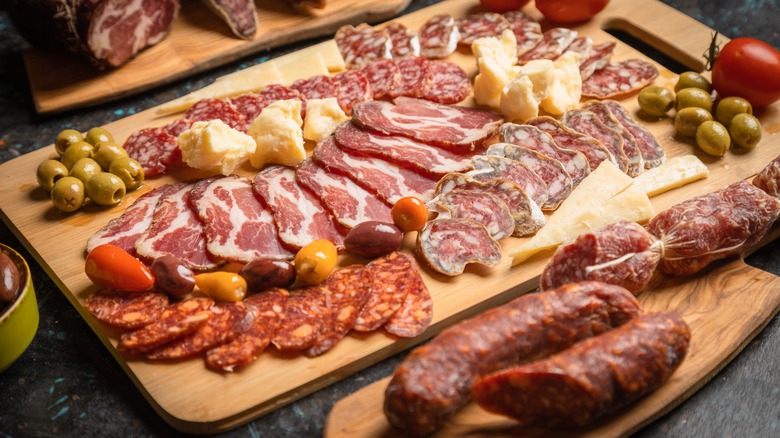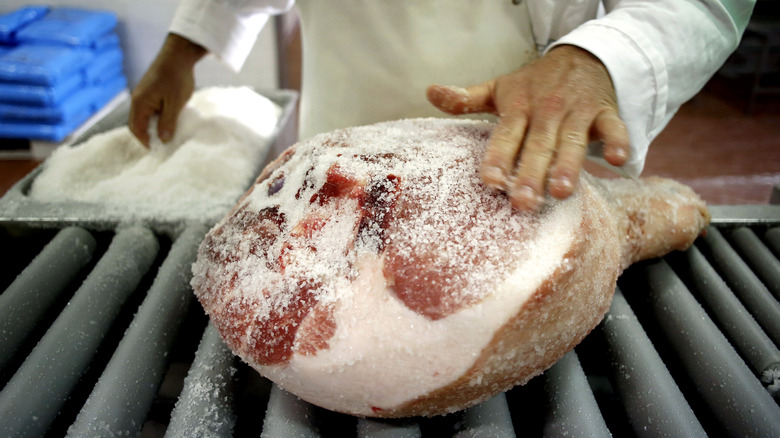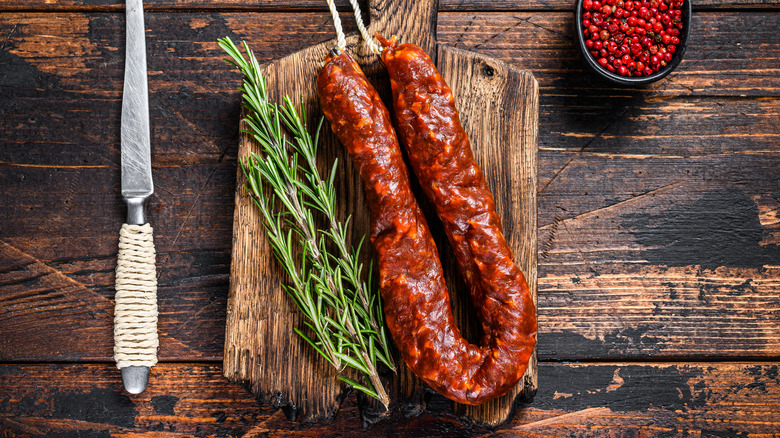What's The Difference Between Cured And Uncured Meat?
Developed to extend the shelf life of meat prior to the advent of refrigeration, preserved meats — including bacon, prosciutto, and ham — have been made for years via various methods including smoking, salting, fermenting, and brining. In addition to extending the shelf life and reducing bacterial growth by applying salt and other ingredients that remove moisture from the meat, preservation, often referred to as curing, also adds a depth of flavor to many meat products enjoyed on charcuterie boards or savored at breakfast.
Though home cooks may refer to preserved meats as "cured meats," when picking out a variety of delicious preserved meats from the shelves of the grocery store, you'll often notice that a package of bacon or salami is labeled as "cured" or "uncured." This can be confusing — since both are preserved meats, right? Essentially yes, however, the labels "cured" and "uncured" are used and regulated by the USDA on packaged meats to signal to consumers a key difference: if natural vs. synthetic ingredients are used to preserve the meat.
Meats labeled as "cured" use salts, seasonings, and synthetic ingredients — most commonly sodium or potassium nitrites and nitrates — to help preserve the meat longer and result in that reddish-pink color you may be used to seeing in your bacon. On the other hand, "uncured" meats are preserved exclusively using natural ingredients, including salt, sugar, spices, and natural vegetable sources of nitrites and nitrates.
Cured meat uses chemical preservatives
Synthetic nitrates and nitrites have been used in the food industry to extend the shelf life of preserved meats. Sodium ascorbate (or a synthetic form of Vitamin C) is often used to preserve and boost the flavor and color of pork. However, in recent years, concern has risen about the level of nitrites used in meat and their detrimental effect on overall health, including their carcinogenic risk and cured meat's possible link to worse asthma symptoms. In response, many food manufacturers have leaned on older tried-and-true natural preservation ingredients to cure their meat, resulting in packaged meat products labeled as "uncured."
In these uncured natural preservation styles, the same curing processes are used, just without synthetic additives that may be harmful to consumers' health — including chemical nitrites and nitrates. Natural ingredient alternatives include beets, garlic, or celery powder, which contain naturally-occurring nitrites as well as Vitamin C, which helps preserve the meat.
Uncured, naturally preserved meats typically have a shorter shelf life, sometimes 30 to 50 days less than meats cured with chemical preservatives. So, when buying uncured meats, it's important to pay attention to best-by dates and to make sure you're buying the amount you need and can consume in a given time, in order to reduce food waste.
Types of preserved meats
To preserve meat, dry or wet curing may be used to draw out moisture and reduce bacterial growth. Salt, sugar, and spices can be applied generously in a dry rub for a dry-curing process — as is done with flavorful meats like pancetta (dry-cured pork belly) and prosciutto (dry-cured ham). Meat can also be placed in a brine of salt and water, or injected with brine, for wet-curing methods — as is the case with bacon — in which pork belly and other meats are typically injected with a wet brine. Both methods often involve refrigeration as the meat cures.
There are also combination methods, as well as sausage methods which combine salt and other moisture-retaining ingredients into ground meat, like those used to make Spanish chorizo. After curing the meat with natural ingredients (for uncured meat products), or a combination of natural and synthetic ingredients (for cured meats), the meat then undergoes further preservation and flavoring methods, such as fermenting, smoking, and air-drying.
Choose "uncured" meats for a more health-conscious choice with all-natural ingredients, or go for meats labeled as "cured" if shelf-life is your primary concern (noting that the meat contains synthetic food additives).


